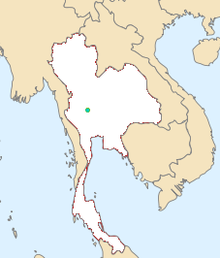Sirintara Tern
| Sirintara Tern | ||||||||||||
|---|---|---|---|---|---|---|---|---|---|---|---|---|

Sirintara swallow ( Pseudochelidon sirintarae ) |
||||||||||||
| Systematics | ||||||||||||
|
||||||||||||
| Scientific name | ||||||||||||
| Pseudochelidon sirintarae | ||||||||||||
| Thonglongya , 1968 |
The Sirintara swallow ( Pseudochelidon sirintarae ), also known as the white-eyed swallow , is one of two species from the genus of the swallow ( Pseudochelidon ) within the swallow family . It is only known from a wintering site at Bueng Boraphet in central Thailand . Presumably it became extinct as there has been no reliable evidence since 1980. The Thai princess Maha Chakri Sirindhorn is honored with the art epithet .
description
The Sirintara tern reaches a length of 18 centimeters. The head and chin are velvet black with a bluish sheen. The top and tail are glossy green-black and contrast with a silvery-white rump band. The wings are black and have a light brown color along the inner vents. The underside is black and has a bluish green sheen. Characteristic are two 9 cm long middle tail feathers with thin wire-like pennants. The eyes are white. The beak is greenish yellow with a black tip. The legs are flesh-colored. The head and underside of juvenile birds are brown. They lack the elongated tail feathers.
Occurrence and habitat
The Sirintara tern was discovered by the Thai ornithologist Kitti Thonlongya , who collected nine specimens in 1968. The birds were caught with nets at the largest freshwater lake in Thailand, Bueng Boraphet , in Nakhon Sawan Province . The Sirintara tern was only observed at the lake between November and February, so that it is assumed that the region around the Buen Boraphet represents a wintering area of the species. The breeding areas, however, were never discovered.
status
In 1971 a couple was kept for a short time at Dusit Zoo in Bangkok . In February 1978, six adults and four juveniles in January 1980 were observed at the Bueng Boraphet. Unconfirmed sightings are said to have taken place in Thailand in 1986 and in Cambodia in 2004 .
Despite legal protection, the Sirintara tern was hunted and sold as food for devout Buddhists . At least 120 specimens were shot by professional bird hunters and offered in markets. Other possible reasons for the decline of the species were the destruction of the resting places, the disturbance of the river sandbanks, flooding as well as the change of the hydrology by dams. In 1975 a no-hunting zone was set up at Buen Boraphet. In addition, the Sirintara tern is listed in Appendix I of the CITES agreement.
literature
- Lekagul, Boonsong; Round, Philip (1991): A Guide to the Birds of Thailand . Bangkok: Saha Karn Baet. ISBN 974-85673-6-2 . P. 233
- Craig R. Robson (2004): A Field Guide to the Birds of Thailand . New Holland Press. ISBN 1-84330-921-1 . P. 206
- Hirschfeld, Erik (2007): Rare Birds Yearbook 2008 . England: MagDig Media Lmtd, 208. ISBN 978-0-9552607-3-5 .
- Kitti, Thonglongya (1968): A new martin of the genus Pseudochelidon from Thailand. Thai National Scientific Papers, Fauna Series no.1.
- Josep del Hoyo ; Elliot, A. & Christie D. (Editors) (2004): Handbook of the Birds of the World . Volume 9: Cotingas to Pipits and Wagtails . Lynx Edicions. ISBN 84-87334-69-5
- Johannes Erritzøe (1993): The Birds of CITES and How to Identify them ; Lutterworth Press, Cambridge. ISBN 0-7188-2891-7
Web links
- Eurochelidon sirintarae in the Red List of Threatened Species of the IUCN 2008. Posted by: BirdLife International, 2008. Accessed January 13 of 2009.
- Oriental Bird Club Bulletin: Little-known Oriental bird, White-eyed River-Martin Eurochelidon sirintarae in the Oriental Bird Club Bulletin 31; June 2000
- Criticism of the article Little-known Oriental bird, White-eyed River-Martin Eurochelidon sirintarae
